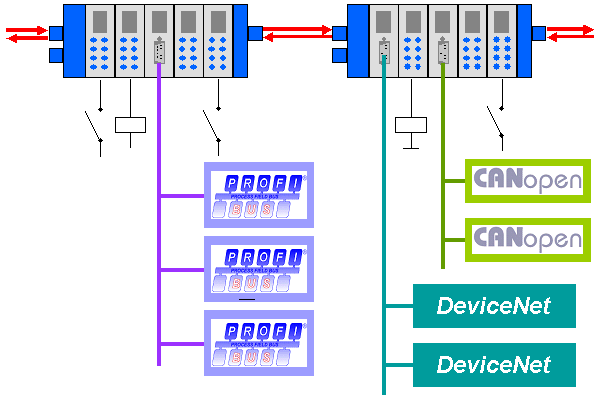Application areas
Control loops via the bus
In conjunction with fast machine control systems the outstanding performance of EtherCAT can be demonstrated particularly well. The bus system offers access speeds similar to local I/Os. EtherCAT enables not only the position control loop, but also the velocity control loop or even the current control loop to be closed via the bus, resulting in cost-effective drive controllers. EtherCAT therefore takes full advantage of the performance of fast PC-based control technology. The IPCs become small and economical, since slots are avoided: Expansion cards are also controlled via EtherCAT.
EtherCAT is not only suitable for very fast applications. Since all protocol processing takes place in hardware, the technology only places low demands on the master connection: a commercially available Ethernet Controller is sufficient. The master only has to send EtherCAT frames cyclically or as required – mapping, addressing, node monitoring etc. takes place in the slave ASICs. The input process image arrives at the master fully sorted and therefore ready prepared for the control application. For simple cyclic applications with a process image size of up to 1486 bytes, only one telegram has to be processed in the master, consisting almost exclusively of the process data. Larger process images are distributed over several frames.
EtherCAT may therefore be the fieldbus technology placing the lowest demands on the master.
EtherCAT instead of PCI
With increasing miniaturisation of the PC-components, the physical size of Industrial PCs is increasingly determined by the number of required slots. The bandwidth of Fast Ethernet, together with the data width of the EtherCAT communication hardware (FMMU chip) enables new directions: Interfaces that are conventionally located in the IPC are transferred to intelligent interface terminals at the EtherCAT. Apart from the decentralized I/Os, axes and operating devices, complex systems such as fieldbus masters, fast serial interfaces, gateways and other communication interfaces can be addressed. Even further Ethernet devices without restriction on protocol variants can be connected via decentralized switch port terminals. The central IPC becomes smaller and therefore cost-effective. An Ethernet interface is sufficient for complete communication with the periphery.

Fieldbus devices (e.g. Profibus, CANopen, DeviceNet, AS Interface etc.)
are integrated via decentralised fieldbus master terminals.